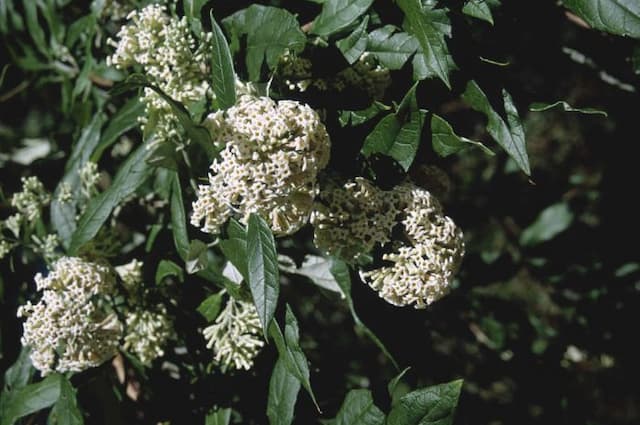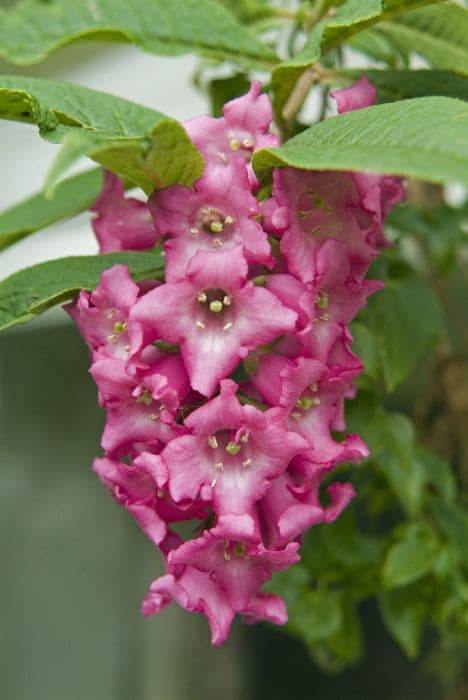Butterfly Bush Buddleja davidii Nanho Purple = 'Monum'
![butterfly bush [Nanho Purple]](/_next/image?url=https%3A%2F%2Fplants-admin.emdemapps.com%2Fimages%2Fplants%2F%2Fimages%2F604b5e3cb2c58.png&w=3840&q=75)
ABOUT
The plant in question is commonly known as the Nanho Purple Butterfly Bush. It features an appealing, bushy form with narrow, lance-shaped leaves that have a silvery-grey to green coloration. Throughout its blooming season, the Butterfly Bush produces delicate, purple blooms that are arranged in elongated clusters, often referred to as panicles. These vibrant flowers are not only striking in their color - a rich, lilac to deep purple hue - but they're also known for their fragrance, which is sweet and honey-like, attracting a variety of pollinators including butterflies, hummingbirds, and bees. The plant's overall aesthetic is one of casual elegance and vibrant color, making it a popular choice for gardeners looking to add a splash of color and wildlife-friendly attributes to their gardens.
About this plant
 Names
NamesFamily
Scrophulariaceae
Synonyms
Nanho Purple Butterfly Bush, Petite Purple Butterfly Bush, Dwarf Butterfly Bush, Purple Buddleia, Summer Lilac
Common names
Buddleja davidii 'Monum'.
 Toxicity
ToxicityTo humans
Butterfly Bush (Buddleja davidii) is generally not considered toxic to humans. There are no well-documented cases of poisoning from ingesting this plant. As with any plant material, ingesting large quantities may cause some discomfort or ill effects such as nausea or stomach upset due to the plant's non-digestible components, but Butterfly Bush is not known for containing any potent toxins that would cause serious harm to humans.
To pets
Butterfly Bush (Buddleja davidii) is also not regarded as toxic to pets. It does not typically cause serious harm if pets, such as dogs or cats, ingest its leaves or flowers. However, as with any non-food plant, its ingestion might result in mild gastrointestinal upset, such as vomiting or diarrhea, simply because it’s not part of their normal diet. If a pet consumes a large amount of the Butterfly Bush, it is advisable to monitor them and consult with a veterinarian if any unusual symptoms occur.
 Characteristics
CharacteristicsLife cycle
Perennials
Foliage type
Deciduous
Color of leaves
Green
Flower color
Purple
Height
5 feet (1.5 meters)
Spread
4 feet (1.2 meters)
Plant type
Shrub
Hardiness zones
5
Native area
China
Benefits
 General Benefits
General Benefits- Attracts Wildlife: The blossoms of the Butterfly Bush are a magnet for butterflies, bees, and hummingbirds, providing a source of nectar and contributing to biodiversity.
- Landscape Beauty: It offers aesthetic appeal with its deep purple flowers, adding a splash of color to any garden landscape.
- Low Maintenance: This plant is known for being easy to care for, requiring minimal upkeep once established, which is beneficial for beginner gardeners or those with limited time.
- Drought Tolerant: Once established, it exhibits a degree of drought tolerance, making it suitable for xeriscaping and reducing the need for frequent watering.
- Rapid Growth: 'Monum' is a fast-growing variety, allowing gardeners to enjoy its blooms fairly quickly after planting.
- Erosion Control: The plant can help stabilize soil and control erosion, particularly when planted on slopes or areas prone to losing topsoil.
- Long Blooming Period: It has a lengthy flowering season, typically from early summer to the first frost, which ensures lasting visual interest.
 Medical Properties
Medical PropertiesThis plant is not used for medical purposes.
 Air-purifying Qualities
Air-purifying QualitiesThis plant is not specifically known for air purifying qualities.
 Other Uses
Other Uses- Butterfly feeding stations: The Buddleja davidii 'Nanho Purple', commonly known as Butterfly Bush, can be planted in butterfly gardens to attract and feed numerous species of butterflies due to its nectar-rich flowers.
- Natural privacy screens: Because of its dense foliage and fast growth, it can provide a lush, natural privacy screen in gardens or along borders.
- Erosion control: Its root system can help stabilize sloping ground and prevent soil erosion in landscaping.
- Photography backdrop: The vibrant purple flowers can serve as a beautiful backdrop for outdoor photography sessions.
- Bee gardens: Similar to butterflies, bees are also attracted to the Butterfly Bush, making it a valuable addition to bee-friendly gardens to support pollinator populations.
- Artistic inspiration: Artists may use the vibrant colors and forms of the Butterfly Bush as inspiration for paintings, illustrations, or textile designs.
- Theme gardens: This plant can be a part of a purple-themed garden, complementing other purple flowers and foliage.
- Sensory gardens: With its fragrant flowers and textured leaves, the Butterfly Bush can be included in sensory gardens designed for therapeutic and educational purposes.
- Educational tool: The plant can serve as an educational tool in schools and nature programs to teach about plant growth, pollination, and the importance of supporting local ecosystems.
- Culinary decoration: While not edible, its flowers can occasionally be used as non-toxic decorations for cakes and platters, provided they're pesticide-free and thoroughly washed.
Interesting Facts
 Feng Shui
Feng ShuiThe Butterfly Bush is not used in Feng Shui practice.
 Zodiac Sign Compitability
Zodiac Sign CompitabilityThe Butterfly Bush is not used in astrology practice.
 Plant Symbolism
Plant Symbolism- Renewal - Buddleja, commonly known as Butterfly Bush, often symbolizes renewal and new beginnings as it attracts butterflies which are a metaphor for transformation.
- Hope - The plant’s capacity to attract butterflies is also seen as a representation of hope and the possibility of change.
- Encouragement - With its rapid growth and prolific blooming, the Butterfly Bush stands for encouragement and support, inspiring people to grow and thrive.
- Attraction - Just as the Butterfly Bush draws in butterflies and other pollinators, it can symbolize attraction or the ability to attract what you desire.
- Recovery - Due to its resilient nature and ability to bounce back after pruning, this plant can represent recovery from adversity or illness.
 Water
WaterButterfly Bush 'Nanho Purple' prefers consistent moisture, so water it deeply once a week, providing about 1 to 1.5 gallons of water each time. During hot or dry periods, increase the frequency to twice a week. If the plant is established and there has been a decent amount of rain, you can reduce watering somewhat but do not allow the soil to completely dry out. In containers, water until it runs out of the drainage holes, ensuring the soil is moist but not waterlogged. Be cautious of over-watering as this can lead to root rot.
 Light
LightButterfly Bush 'Nanho Purple' thrives in full sun, requiring at least 6 to 8 hours of direct sunlight daily to bloom prolifically. It will tolerate some light shade, but this may reduce the number of flowers and cause the plant to grow leggy as it stretches for light. The best spot for this plant is in a location where it's exposed to unfiltered sunlight for the majority of the day.
 Temperature
TemperatureButterfly Bush 'Nanho Purple' is hardy and can tolerate temperatures as low as 20°F and as high as 100°F, but it thrives in the moderate range of 60°F to 80°F. Protect it from extreme cold by providing mulch insulation around the base during winter, especially in areas where temperatures can drop below its minimum tolerance threshold.
 Pruning
PruningButterfly Bush 'Nanho Purple' should be pruned in late winter or early spring before new growth begins. Prune back to 12 to 24 inches from the ground to maintain shape and to encourage prolific blooming. Deadheading spent flower spikes throughout the growing season will also promote continuous flowering. The best time for pruning is when the threat of hard frost has passed.
 Cleaning
CleaningAs needed
 Soil
SoilButterfly Bush 'Nanho Purple' thrives in well-draining soil enriched with organic matter. The ideal soil pH for this plant ranges from 6.0 to 7.0. A mixture of garden soil, compost, and sharp sand or perlite can provide the right texture and nutrients. Regular mulching helps maintain soil moisture and temperature.
 Life cycle
Life cycleBuddleja davidii 'Nanho Purple', commonly known as Nanho Purple Butterfly Bush, begins its life cycle through seed germination or vegetative propagation from cuttings. Upon taking root, the seedling or cutting enters a vegetative stage, growing leaves and stems vigorously, especially in warm weather. The plant soon reaches maturity and starts the reproductive phase, characterized by the prolific blooming of purple flowers that are highly attractive to butterflies and other pollinators, usually in its second year. After the flowering season, the plant produces small capsule-like fruits that release seeds, completing its reproductive cycle. During the winter or dormant season, the Butterfly Bush may die back, especially in colder climates, requiring pruning to encourage new growth and to maintain a desirable shape. With the return of spring, the plant resumes growth, completing its annual life cycle, and continues this pattern for many years, although periodic rejuvenation may be necessary to maintain vigor and flowering performance.
 Propogation
PropogationPropogation time
Spring-Early Summer
The most popular method of propagation for the Butterfly Bush (Buddleja davidii 'Nanho Purple') is through semi-hardwood cuttings. This is typically done in late summer. The process involves selecting a healthy stem that has matured but is not yet completely woody and cutting a piece about 6 inches (15 cm) in length. The leaves on the lower half of the cutting are then removed, and the cut end is dipped in rooting hormone to facilitate root growth. The treated cutting is then planted in a well-draining soil mix, ensuring the remaining leaves are above the soil surface. The cutting should be kept moist and in indirect light until roots have developed, which usually takes a few weeks, after which it can be transplanted into the garden or a larger container.

![Butterfly bush [Berries and Cream]](/_next/image?url=https%3A%2F%2Fplants-admin.emdemapps.com%2Fimages%2Fplants%2F%2Fimages%2F604b650f667be.png&w=640&q=75)






